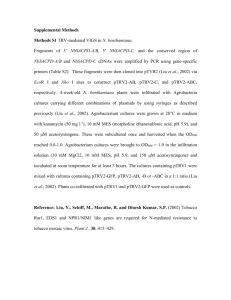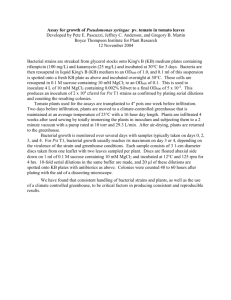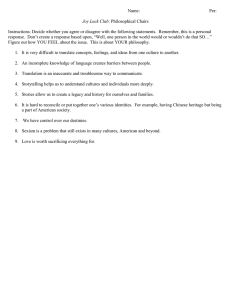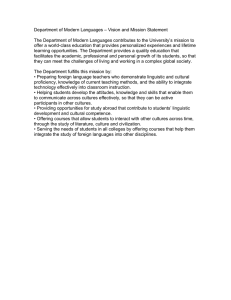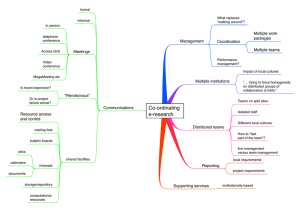Supplemental Material Supplementary Methods
advertisement
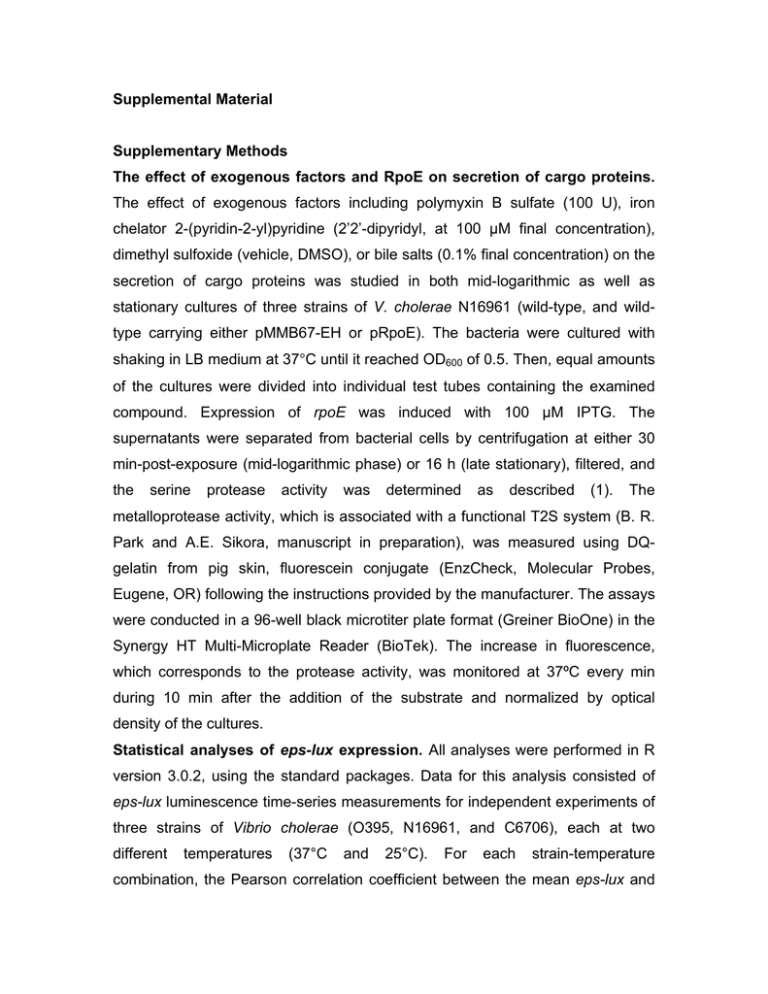
Supplemental Material Supplementary Methods The effect of exogenous factors and RpoE on secretion of cargo proteins. The effect of exogenous factors including polymyxin B sulfate (100 U), iron chelator 2-(pyridin-2-yl)pyridine (2’2’-dipyridyl, at 100 µM final concentration), dimethyl sulfoxide (vehicle, DMSO), or bile salts (0.1% final concentration) on the secretion of cargo proteins was studied in both mid-logarithmic as well as stationary cultures of three strains of V. cholerae N16961 (wild-type, and wildtype carrying either pMMB67-EH or pRpoE). The bacteria were cultured with shaking in LB medium at 37°C until it reached OD600 of 0.5. Then, equal amounts of the cultures were divided into individual test tubes containing the examined compound. Expression of rpoE was induced with 100 µM IPTG. The supernatants were separated from bacterial cells by centrifugation at either 30 min-post-exposure (mid-logarithmic phase) or 16 h (late stationary), filtered, and the serine protease activity was determined as described (1). The metalloprotease activity, which is associated with a functional T2S system (B. R. Park and A.E. Sikora, manuscript in preparation), was measured using DQgelatin from pig skin, fluorescein conjugate (EnzCheck, Molecular Probes, Eugene, OR) following the instructions provided by the manufacturer. The assays were conducted in a 96-well black microtiter plate format (Greiner BioOne) in the Synergy HT Multi-Microplate Reader (BioTek). The increase in fluorescence, which corresponds to the protease activity, was monitored at 37ºC every min during 10 min after the addition of the substrate and normalized by optical density of the cultures. Statistical analyses of eps-lux expression. All analyses were performed in R version 3.0.2, using the standard packages. Data for this analysis consisted of eps-lux luminescence time-series measurements for independent experiments of three strains of Vibrio cholerae (O395, N16961, and C6706), each at two different temperatures (37°C and 25°C). For each strain-temperature combination, the Pearson correlation coefficient between the mean eps-lux and mean OD600 time series was computed. To directly compare the mean eps-lux time-series from one strain-temperature combination to another, the correlation matrix for the six different mean eps-lux time series was calculated. The correlations between the mean time series were subsequently used to construct a distance for clustering the strain-temperature experiments. The distance between two different experiments is defined as 1 - Cor(eps-luxi, eps-luxj), where eps-luxi and eps-luxj are two different strain-temperature time series. This will result in experiments with mean eps-lux time series that are highly correlated with each other having small distances, and therefore being placed in the same cluster. References: 1. Sikora AE, Lybarger SR, Sandkvist M. 2007. Compromised outer membrane integrity in Vibrio cholerae Type II secretion mutants. J. Bacteriol. 189:8484-8495. Supplementary Figures Fig. S1. Correlation between eps-lux expression and bacterial growth (A). Correlation matrix with a corresponding heat map for the different mean eps-lux series (B). Hierarchical clustering dendrogram for the strain-temperature experiments (C). Fig. S2. Analysis of the timing of the peak eps-lux expression between different V. cholerae classical (O395) and El Tor (N16961, C6706) strains. The time series of mean eps-lux luminescence is plotted in black when there is a statistically significant difference (at level α = 0.05) between the mean eps-lux at that time point and the peak mean; it is plotted in red when there is no statistically significant difference between the mean eps-lux and the peak mean. Fig. S3. Kinetics of eps expression in V. cholerae C6706 wild-type and ΔhapR strains. Bacterial strains were cultured in LB media at 37°C in 96-well white, clear bottom microtiter plates. The turbidity of the cultures at OD600 and eps-lux activity, luminescence, was assessed in technical triplicates and recorded every 20 min throughout 16 h. Each datum point represents the mean and SEMs obtained from at least five independent experiments. Fig. S4. Kinetics of tarp expression in V. cholerae classical O395 strain. Bacterial strains were cultured in 96-well white, clear bottom microtiter plates in LB media at either 25°C or 37°C, and under conditions either repressing- or inducing virulence gene expression, as indicated. The turbidity of the cultures at OD600 and eps-lux activity, luminescence, was assessed in technical triplicates and recorded every 20 min throughout 16 h. Each datum point represents the mean and SEMs (n=4). Fig. S5. The effect of exogenous factors and overproduction of RpoE on secretion of cargo proteins. V. cholerae N16961 wild-type, and wild-type carrying either pMMB67-EH (p) or pRpoE were cultured with shaking in LB medium at 37°C until it reached OD600 of 0.5. Then, equal amounts of the cultures were divided into individual test tubes containing the examined compound including 100 U polymyxin B sulfate, DMSO (vehicle), 100 µM 2’2’dipyridyl, or 0.1% bile salts. Expression of rpoE was induced with 100 µM IPTG. The supernatants were separated from bacterial cells by centrifugation at either 30 min-post-exposure (mid-logarithmic phase) or 16 h (late stationary), filtered, and the serine- and metallo-protease activities were determined using specific fluorogenic substrates as described in Supplementary Methods. The increase in fluorescence, which corresponds to the protease activity, was monitored at 37ºC every min during 10 min after the addition of the substrate and normalized by optical density of the cultures. Each bar represents the mean and SEMs (n=3).
